In some cases, you may need geometrically irregular or complex pad shapes in your design, and getting them just right will take a lot of time and manual work. Learn how to save time and energy by quickly applying complex pad shapes to PCB design in AltiumDesigner®. Keep reading to learn more.
Most component package types have consistent and intuitive rectangular or circular pad shapes. Creating a package for this type of package manually or using an automatic IPC footprint generator is a simple process. However, component packaging occasionally requires complex pad shapes, which can result in significant manual operations and spend extra time to make it just right. What if there is a way to quickly apply complex pad shapes to PCB design to save time and effort?
In some cases, your design may require pads with complex or irregular shapes. For example, LED lighting components may require uniquely shaped heat dissipation pads with multiple reverse curves. It is impossible to achieve this kind of curve by combining multiple standard circular/rectangular pads or by manually placing fillers or solid areas. However, there is a method that is often overlooked, that is, if the contour of the desired shape can be placed (or imported) as a series of tracks and arcs forming a closed contour, the contour itself can be easily converted into a precise in the PCB editor -Form the shaped solid area of the pad. In addition, welding and pasting masks can be automatically controlled by DRC rules through the attribute settings of the area objects. To better understand this approach, the entire process can be explored by creating a footprint for the Bourns SRR5028 series of shielded SMD power inductors, as described below. To get started, the data sheet for this example on the manufacturer's website can be found here, part number SRR5028-101Y. Each pad of the two-pin device includes a reverse curve with a radius of 2.2 mm. Let us now explore how to define the pad shape outline using the examples provided in the data sheet.

Define the outline of the pad shape
In the series data sheet of the recommended layout part of SRR5028, the key dimensions of the component pads are described relative to the component origin. In the PCB layout editor, six lines and an arc are placed on the mechanical layer to capture these key dimensions of each pad relative to the component origin. Then verify that the precise dimensions and positions of these lines and arcs fully comply with the manufacturer's dimensions shown in the data sheet. Setting the snap grid to 0.05 mm in the PCB editor ensures that the manufacturer's dimensions can be accurately reproduced.
Create a mechanical profile (right) from the manufacturer's data sheet (left).
Now that the key dimensions of the component pad have been placed and verified, any extraneous lines or arcs can be sliced, resized or completely removed, so that the final result is only two closed contours on the mechanical layer, where each contour represents the shape of the pad . In this example, the closed contour is manually created and verified. Or, you can import complex print pad shape contours from DXF/DWG format, if these data happen to exist and are more practical.
Easily create or import complex pad shapes in Altium
Sometimes, according to the layout recommended by the PCB manufacturer, some components require complex or irregularly shaped pads. Always remember that a simple and effective solution can quickly implement complex pad shapes. By using trajectories and arcs to create or import precise contours of complex pad shapes, the results can be converted into solid area objects.